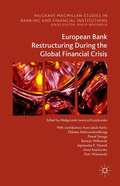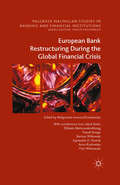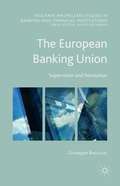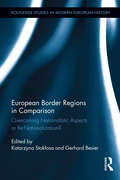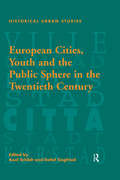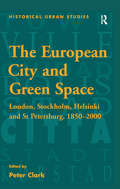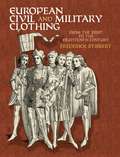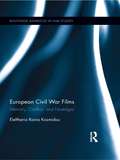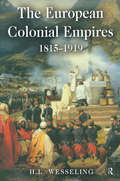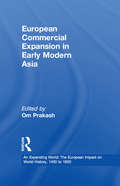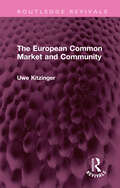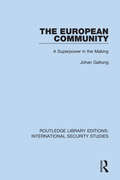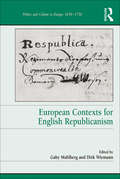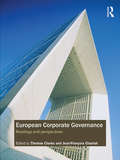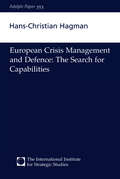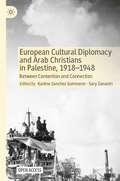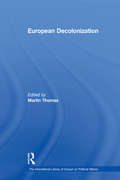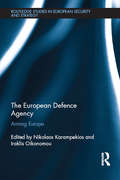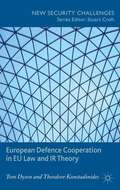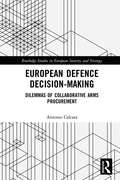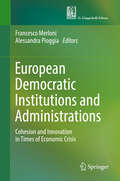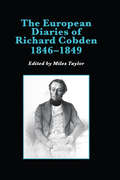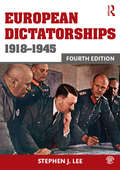- Table View
- List View
European Bank Restructuring During the Global Financial Crisis (Palgrave Macmillan Studies in Banking and Financial Institutions)
by Jakub Kerlin Małgorzata Iwanicz-Drozdowska Paweł Smaga Bartosz Witkowski Anna Kozłowska Elżbieta Malinowska-Misiąg Agnieszka Nowak Piotr WisniewskiThis book explores the diversity of restructuring instruments applied to financial institutions in EU countries during the Global Financial Crisis. It investigates the cost of that support before evaluating its effects, as well as providing an extensive analysis of the measures undertaken. The first chapter presents a historical outline, discusses causes of crises, and offers an overview of the restructuring instruments and of how they were used for crisis management before 2007. The following chapters explore the financial environment in the EU before the crisis outbreak, the rescue actions and financial landscape after the events of the crisis. This book offers a critical and thorough analysis of the financial support provided to banks, providing case studies of over 95 banks from 17 EU member states. The authors provide an in-depth study of the pre and post-crisis landscape, and demonstrate that the crisis has by no means been overcome.
European Bank Restructuring During the Global Financial Crisis (Palgrave Macmillan Studies in Banking and Financial Institutions)
by Jakub Kerlin Elżbieta Malinowska-Misiąg Paweł Smaga Bartosz Witkowski Agnieszka K. Nowak Anna Kozłowska Piotr WiśniewskiThis book explores the diversity of restructuring instruments applied to financial institutions in EU countries during the Global Financial Crisis. It investigates the cost of that support before evaluating its effects, as well as providing an extensive analysis of the measures undertaken. The first chapter presents a historical outline, discusses causes of crises, and offers an overview of the restructuring instruments and of how they were used for crisis management before 2007. The following chapters explore the financial environment in the EU before the crisis outbreak, the rescue actions and financial landscape after the events of the crisis. This book offers a critical and thorough analysis of the financial support provided to banks, providing case studies of over 95 banks from 17 EU member states. The authors provide an in-depth study of the pre and post-crisis landscape, and demonstrate that the crisis has by no means been overcome.
The European Banking Union: Supervision And Resolution (Palgrave Macmillan Studies in Banking and Financial Institutions)
by Giuseppe BoccuzziThe 2008 financial crisis all but brought down the financial system and real economies of industrial countries. The Banking Union took a broad approach to resolve the structural fragmentation and distortions in the European banking system which were major obstacles to a working single market for financial services. This book examines the numerous changes happening to European legislations for the prevention and management of banking crises. What emerges is a changing picture of regulations and institutions, of goals, tools and opinions, public and private, European and national all involved in the task. The book focuses on the new framework for banking crisis management, starting from the foundations of banking regulation and supervision. It explores the institutional architecture of banking supervision and crisis management, the powers of the authorities, the tools for administrative actions, the complexities of business and bankruptcy laws, individual rights and their legal guarantees.
European Border Regions in Comparison: Overcoming Nationalistic Aspects or Re-Nationalization? (Routledge Studies in Modern European History #21)
by Gerhard Besier Katarzyna StokłosaBorders exist in almost every sphere of life. Initially, borders were established in connection with kingdoms, regions, towns, villages and cities. With nation-building, they became important as a line separating two national states with different “national characteristics,” narratives and myths. The term “border” has a negative connotation for being a separating line, a warning signal not to cross a line between the allowed and the forbidden. The awareness of both mental and factual borders in manifold spheres of our life has made them a topic of consideration in almost all scholarly disciplines – history, geography, political science and many others. This book primarily incorporates an interdisciplinary and comparative approach. Historians, sociologists, anthropologists and political science scholars from a diverse range of European universities analyze historical as well as contemporary perceptions and perspectives concerning border regions – inside the EU, between EU and non-EU European countries, and between European and non-European countries.
European Cities, Youth and the Public Sphere in the Twentieth Century (Historical Urban Studies Series)
by Detlef SiegfriedThe late nineteenth century witnessed unprecedented levels of urban growth as migration swelled the population of European cities to new heights. The resulting problems of overcrowding and inadequate civic utilities prompted the governing elites to look for new planning solutions to address the needs of an increasingly urbanised society. At the same time young people were also increasingly recognised as being adversely affected, both politically and morally, by the on-going process of urbanization. Church groups, civic authorities, middle-class reformers and political movements all tried to steer youth toward their own concept of respectable behaviour, concepts that often tended to share many similarities in their paternalistic emphasis upon social discipline. This volume directly addresses the confluence of these issues, the point at which the city government, youth and public space meet and the resulting problems and tensions that were often created. Whether it be the corruption of the rural youth flooding into the cities at the beginning of the twentieth century, battles between Hitler Youth and working-class gangs in Nazi Germany, hooliganism in 1950s Hungary or the appropriation of, or withdrawal from, public spaces by youths in more recent times, all the chapters in this book explore ways in which authorities and adult groups have sought to control young people, both directly and indirectly. Drawing on a broad selection of methods and disciplines, a wide variety of case studies from across Europe are used to investigate the interactions between youth and authority, and show how these adapted and changed over time and in different countries. By taking a fresh look at these issues within a comparative framework, this volume furthers our understanding of modern European society during the twentieth century.
The European City and Green Space: London, Stockholm, Helsinki and St Petersburg, 1850–2000 (Historical Urban Studies Series)
by Peter ClarkRecent years have seen sustained public debate and controversy over the 'greening' of European cities, associated with the environmental movement, pressures of urban redevelopment, and the promotional strategies of cities competing in a global market. But the European debate over urban green space has a long history dating back to Victorian concerns for the 'green lungs' of the city to combat the health and social problems caused by rapid population and industrial growth. This book explores the multiplicity of green space developments in the modern city - ranging over parks and commons, garden suburbs and the cities in the park, allotment gardens, green belts and national urban parks. It is concerned not only with the different types of green space but the many influences shaping their evolution, from international planning ideas, to the rise of modern-day sport and leisure, and the effects of the transport revolution. No less vital in this story is the interaction of the many actors involved in the often fractious political process of creating green spaces - architects and planners, politicians, developers and other businessmen, NGOs and local residents. This volume is particularly concerned with contexts: how international planning ideas are transmitted and adapted in different European cities; how the construction of green space is affected by local power structures and relationships; and how ordinary people perceive and use green spaces, quite often at variance with official designs. The European City and Green Space looks at these and other issues through the prism of four metropoles - London, Stockholm, Helsinki and St Petersburg. All represent different types of North European city, yet each has experienced distinctive economic, political and cultural trajectories, whilst also facing powerful challenges and problems of similar kinds with regard to green space. This volume examines how each has responded to them and what patterns emerge.
European Civil and Military Clothing: From The First To The Eighteenth Century (Dover Fashion and Costumes)
by Sir Frederic StibbertA wealthy Anglo-Italian connoisseur devoted to the nineteenth-century struggle for Italian unification, Frederick Stibbert amassed an extensive collection of arms, armor, and costume -- which today can be found in the Tuscan museum bearing his name. During the years in which he built up the museum's collection, he examined countless illuminated manuscripts, ancient documents, frescoes, paintings, and other records of armor and dress.The illustrations in this book, based on exceptional drawings by Stibbert himself and engraved by leading craftsmen of the day, reveal a remarkable panorama of European costume history. The volume contains 217 handsome plates depicting nearly 1,000 individual figures and their accessories, all scrupulously accurate and rendered in meticulous detail. Here are excellent illustrations of priests, warriors, Roman citizens, and women of ancient Britain; the German Emperor Otto and his wife; French monarchs and Scottish kings; jousting English knights of the thirteenth century; fifteenth-century Italian gentlewomen; elaborately coiffed ladies from the court of Versailles; and much more. Captions give the origins of the armor and dress, the sources of the drawings, precise descriptions of each item represented, and explanations of the function and manner of wearing armor.This extraordinary work has wide appeal: fashion historians will be attracted by its scrupulous accuracy and the authenticity of the garments; the royalty-free illustrations will be prized by artists and illustrators; and the handsome engravings and informative captions will entertain and instruct readers interested in the history of costume.
European Civil War Films: Memory, Conflict, and Nostalgia (Routledge Advances in Film Studies)
by Eleftheria Rania KosmidouThis book examines the ways in which late twentieth-century European cinema deals with the neglected subject of civil war. Exploring a range of films about the Spanish, Irish, former Yugoslavia, and Greek civil wars, this comparative and interdisciplinary study engages with contemporary debates in cultural memory and investigates the ways in which cinematic postmemory is problematic. Many of the films present an idealized past that glosses over the reality of these civil wars, at times producing a nostalgic discourse of loss and longing. Other films engage with the past in a melancholic fashion. These cinematic discourses articulate contemporary concerns, especially the loss of ideology and a utopian political horizon in the aftermath of the collapse of the Soviet bloc in 1989, a date that marks a significant break in European history and an accompanying paradigm shift in European cultural memory. Filmmakers examined include Trueba, Cuerda, Loach, Jordan, Kusturica, Dragojević, and Angelopoulos.
The European Colonial Empires: 1815-1919 (Studies In Modern History)
by H. L. WesselingThe nineteenth century was Europe's colonial century. At the beginning of the period, the only colonial empire that existed was the British Empire. By the end of the century the situation was completely different and Europe's colonial possessions had come to constitute a large part of the world. The French had acquired an immense colonial empire and the Dutch had extended their control over Indonesia. Germany and Italy, unified only in the latter half of the century, had claimed their place under the sun. Even the tiny Kingdom of Belgium had acquired a huge colonial territory in Africa: the Belgian Congo. This is the first book to describe the whole process of colonization from conquest to pacification, and to analyze it in the light of administrative, cultural and economic developments. The European Colonial Empires discusses a uniquely long period instead of merely focussing on the shorter, accepted age of classical imperialism. Wesseling argues that European colonial expansion can be understood only by putting it into this long-term perspective and by comparing the differences between the colonies in Africa, Asia, Oceania and the Caribbean. This book redresses the balance that privileges the British colonial and imperial experience. It emphasizes the continental European experience while relating developments to the British enterprise.
European Colonialism since 1700
by James R. LehningThis masterful synthesis provides a much-needed, complete survey of European colonialism from 1700 to decolonization in the twentieth century. Written by an award-winning author, this advanced undergraduate and graduate level textbook bridges, for the first time, the early modern Atlantic empires and the later Asian and African empires of 'high imperialism'. Viewing colonialism as a phenomenon of contact between Europe and the rest of the world, the author takes an 'entangled histories' approach, considering the surprising ways in which the imperial powers of Spain, Portugal, Great Britain, France and the Netherlands displayed their identities in colonial settings, as much as in their imperial capitals. The author illuminates for students the common themes of colonial government, economic development and cultural contact across empires, and reveals the ways in which these themes played out, through contrast of the differing development, structure and impact of each empire.
European Commercial Expansion in Early Modern Asia (An Expanding World: The European Impact on World History, 1450 to 1800 #10)
by Om PrakashRegular commercial contacts between Europe and Asia date back to at least the early years of the Christian era, but the pattern of trade underwent a structural modification following the Portuguese discovery of a route to the East Indies via the Cape of Good Hope. This volume illustrates the consequences of the arrival of large numbers of Europeans in the East. Europeans both participated in, modified and exploited existing trade relationships in the Indian Ocean and the Pacific. The studies reprinted here show how some environments, such as Japan, were hostile, whilst most states welcomed the European commercial contact. The necessity for Europeans to pay for Asian goods using precious metals is emphasised by the inclusion of articles in monetary transfers in Asian trade, a phenomenon which provides a link between economic developments in the Americas and those in Asia from the 16th century onwards.
The European Common Market and Community (Routledge Revivals)
by Uwe KitzingerOriginally published in 1967, though with an enduring relevance as Britain once again navigates its role outside the EU, this book is a selection of documents which illustrate how the former European Economic Community came into being. The reader is invited to make up their mind about the arguments for and against British participation in the Common Market. The author introduces his evidence with an historical interpretation of the situation and concludes with an assessment of the significance of the Community concept in the world as well as in Europe.
The European Community: A Superpower in the Making (Routledge Library Editions: International Security Studies #7)
by Johan GaltungThis book, first published in 1973, analyses the European Community in a global perspective. It asks and answers two main questions: what does the European Community mean to the masses of the world, and what does it mean to the world community in general? Most critical studies of the EC were made from an internal point of view, and this book is rare in having an external perspective. The author discussed the EC with diverse audiences in 16 countries, and his analyses are invaluable in putting the European project in an international context.
European Contexts for English Republicanism (Politics and Culture in Europe, 1650-1750)
by Gaby Mahlberg Dirk WiemannEuropean Contexts for English Republicanism offers new perspectives on early modern English republicanism through its focus on the Continental reception of and engagement with seventeenth-century English thinkers and political events. Looking both at political ideas and at the people that shaped them, the collection examines English republican thought in its wider European context during the later seventeenth and eighteenth century. In a number of case studies, the contributors assess the different ways in which English republican ideas were not only shaped by the thought of the ancients, but also by contemporary authors from all over Europe, such as Hugo Grotius or Christoph Besold. They demonstrate that English republican thinkers did not only act in dialogue with Continental authors and scholars, their ideas in turn also left a long-lasting legacy in Europe as they were received, transformed and put to new uses by thinkers in France, Italy, the Netherlands, Germany and Poland. Far from being an exclusively transatlantic affair, as much of the established scholarship suggests, English republican thought also left its legacy on the European Continent, finding its way into wider debates about the rights and wrongs of the English Civil War and the nature of government, while later translations of English republican works also influenced the key thinkers of the French Revolution and the liberals of the nineteenth century. Bringing together a range of fresh and original essays by British and European scholars in the field of early modern intellectual history and English studies, this collection of essays revises a one-sided approach to English republicanism and widens the scope of study beyond linguistic and national boundaries by looking at English republicans and their continental networks and legacy.
European Corporate Governance: Readings and Perspectives
by Thomas Clarke Jean-François ChanlatFor decades, Europe has sought to become more financially integrated with the United States and thus European legal institutions, regulatory, governance and accounting practices have faced pressures to adapt to international competitive markets. Against this backdrop, European corporate governance systems have been criticized as being less efficient than the Anglo-American market based systems. This textbook examines the unique dimensions and qualities of European corporate governance. Reforms of key institutions, the doctrine of shareholder value and the seemingly irresistible growth of CEO power and reward are critically analyzed. The book brings out the richness of European corporate governance systems, as well as highlighting historical weaknesses that will require further work for a sustainable corporate governance environment in the future. In light of the most severe financial crisis since the 1930s, this intelligent look at European corporate governance is a vital textbook for courses on corporate governance and a great supplementary textbook on a host of business, management and accounting classes.
European Crisis Management and Defence: The Search for Capabilities (Adelphi series)
by Hans-Christian HagmanAssesses the EU and NATO's tools to prevent conflicts and manage international crises. It offers a unique insight into European security policy and questions the realism of the political goals. It argues for more coordination among European states, and an enhancement of the EU's strategic decision-making capabilities.
European Cultural Diplomacy and Arab Christians in Palestine, 1918–1948: Between Contention and Connection
by Karène Sanchez Summerer Sary ZananiriThis open access book investigates the transnationally connected history of Arab Christian communities in Palestine during the British Mandate (1918-1948) through the lens of the birth of cultural diplomacy. Relying predominantly on unpublished sources, it examines the relationship between European cultural agendas and local identity formation processes and discusses the social and religious transformations of Arab Christian communities in Palestine via cultural lenses from an entangled perspective. The 17 chapters reflect diverse research interests, from case studies of individual archives to chapters that question the concept of cultural diplomacy more generally. They illustrate the diversity of scholarship that enables a broad-based view of how cultural diplomacy functioned during the interwar period, but also the ways in which its meanings have changed. The book considers British Mandate Palestine as an internationalized node within a transnational framework to understand how the complexity of cultural interactions and agencies engaged to produce new modes of modernity.
European Decolonization (The International Library of Essays on Political History)
by Martin ThomasThis collection brings together twenty-one key articles that explore the nature and impact of colonial withdrawal. Ranging across all the European colonial powers, the articles discuss various aspects of decolonization, including the role of political violence, changing popular attitudes to empire and the inter-actions between colonial conflict and Cold War.
The European Defence Agency: Arming Europe (Routledge Studies in European Security and Strategy)
by Nikolaos Karampekios Iraklis OikonomouThis volume provides a comprehensive understanding of the European Defence Agency (EDA), the leading EU armaments policy institution. Despite its critical role in European strategic and military affairs as the key hub of European policy-making in the field of armaments, the Agency has hitherto received very little attention by the academic and research community around Europe. To fill this gap in the literature, the book covers a multitude of inter-related themes and topics. Not only does it provide a detailed analysis and assessment of the Agency’s record as the first institution dealing solely with EU armaments policy, but it also links these findings to international relations and European integration theory. Thematically, the contributions go beyond the mere description of achievements, gaps and risks, elaborating on novel themes such as space, offsets, pooling and sharing, and transatlantic armaments relations. The book combines an interdisciplinary approach to the study of European defence with theoretical and ontological pluralism, and seeks to unveil the strategic, industrial, institutional and ideational sources of armaments collaboration and capability development under the aegis of the EDA. The multi-faceted orientation of the book will be of much interest to students of European security, EU institutions, defence studies, arms control and international relations in general.
European Defence Cooperation in EU Law and IR Theory
by Tom Dyson Theodore KonstadinidesThis book offers a novel contribution to the study of post-Cold War European defence. Interdisciplinary in approach, it uses European law to assess the utility of existing theoretical accounts. By exploring the balance of threat theory, it provides new insights into the forces driving and hindering European defence cooperation.
European Defence Decision-Making: Dilemmas of Collaborative Arms Procurement (Routledge Studies in European Security and Strategy)
by Antonio CalcaraThis book comparatively examines the preferences of four key arms-producing states towards European joint armaments programmes. The European defence market is characterised by a mixture of inter-state competition and European cooperation, and this work assesses why countries sometimes decide to cooperate with their partners, while in other instances they refrain from doing so. In order to shed light on this empirical puzzle, the book focuses on state-defence industry relations in the four major European arms producers: France, Germany, Italy and the UK. The main argument is that the public or private governance of industrial suppliers and market size are the two decisive variables that explain the simultaneous presence of cooperation and competition in European defence procurement. Specifically, it argues that in public governance ecosystems, arms industries are able to "capture" the state's decision-making processes to their own advantage. In private governance ecosystems, the state is relatively autonomous from defence industry's influence and able to pursue larger macro-economic and military benefits. Moreover, the strategy pursued by governments and defence firms is decisively shaped by market size because of its importance in determining the relative costs and benefits of collaborative arrangements. This book will be of much interest to students of EU policy, defence studies, European politics and International Relations.
European Democratic Institutions and Administrations: Cohesion and Innovation in Times of Economic Crisis
by Francesco Merloni Alessandra PioggiaThis book presents the results of extensive international comparative research into the effects of the economic and financial crisis on democratic institutions and social cohesion policies. The collected studies describe and analyse the measures (often referred to as "reforms") adopted to counter the crisis and the effects of these measures.It investigates three areas: the impact on the functioning of institutions, with respect to the relationship between representative institutions and governments, and the organisational structure of administrations at national and local levels; the impact that the austerity policies on public spending have on social rights; and the impact on traditional instruments of public action (administrative simplification, public services delivering, the use of common assets).The general findings highlight the effect of reducing the administrative and government capacity of the democratic institutions: the public sector, rather than being innovative and made more effective, declines, offering increasingly poor public services and making bad decisions, fuelling substantive or formal privatisation solutions, which in turn cause further weakening.
The European Diaries of Richard Cobden, 1846–1849
by Miles TaylorAn account of the European vision of one of the most influential statesmen and thinkers of the nineteenth-century. This edition of the previously unpublished travel diaries of the M.P. and economic writer Richard Cobden (1804-1865) is not only a revealing account of Anglo-European politics before, during and after the year of revolutions, but is also a travel guide to Europe in the pre-railway age and a contribution to the intellectual biography of an English provincial radical who became a major European celebrity, one of the founders of Free Trade. During his extensive continental travels Cobden met most of the monarchs and leading statesmen of Europe, as well as artists, writers, churchmen and fellow-travellers. His tour through France, Spain, the Italian states, Austria, Prussia, Russia and the Hanseatic ports let him witness the struggles between order and progress which led to and succeeded the great upheavals of 1848. The diaries reveal Cobden in a new light - a determined European, convinced that economic cooperation and not protectionism and militarism was the only way to preserve international stability.
European Dictatorships 1918–1945
by Stephen J. LeeEuropean Dictatorships 1918-1945 surveys the extraordinary circumstances leading to, and arising from, the transformation of over half of Europe's states to dictatorships between the first and the second world wars. From the notorious dictatorships of Mussolini, Hitler and Stalin to less well-known states and leaders, Stephen J. Lee scrutinizes the experiences of Russia, Germany, Italy, Spain, Portugal and Central and Eastern European states. This fourth edition has been fully revised and updated throughout. New material for this edition includes: the most recent research on individual dictatorships a new chapter on the experiences of Europe's democracies at the hands of Germany, Italy and Russia an expanded chapter on Spain a new section on dictatorships beyond Europe, exploring the European and indigenous roots of dictatorships in Latin America, Asia and Africa. Extensively illustrated with images, maps, tables and a comparative timeline, and supported by a companion website providing further resources for study (www.routledge.com/cw/lee), European Dictatorships 1918-1945 is a clear, detailed and highly accessible analysis of the tumultuous events of early twentieth-century Europe.

